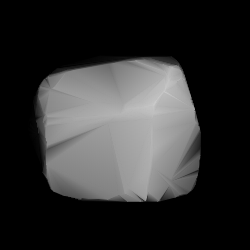
261 Prymno is a somewhat large Main belt asteroid. It is classified as a B-type asteroid and probably has a primitive composition not unlike common C-type carbonaceous asteroids.

273 Atropos is a typical Main belt asteroid that was discovered by Austrian astronomer Johann Palisa on 8 March 1888 in Vienna.
479 Caprera is a minor planet orbiting the Sun.
494 Virtus is an 86 km minor planet orbiting the Sun. It was discovered by Max Wolf on October 7, 1902. Its provisional name was 1902 JV.
500 Selinur is a minor planet, specifically an asteroid orbiting in the asteroid belt. Like 501 Urhixidur and 502 Sigune, it is named after a character in Friedrich Theodor Vischer's then-bestseller satirical novel Auch Einer.
506 Marion is a minor planet orbiting the Sun. It was discovered by Raymond Smith Dugan in February 1903, and was later named after a cousin of his. It is designated as a C-type asteroid with a size of approximately 104 kilometres (64.6 mi).
507 Laodica is a minor planet orbiting the Sun.
521 Brixia is a relatively large minor planet, specifically an asteroid orbiting mostly in the asteroid belt that was discovered by American astronomer Raymond Smith Dugan on January 10, 1904. The name derives from Brixia, the ancient name of the Italian city of Brescia.

578 Happelia is a minor planet orbiting the Sun. On 24 February 2017 a possible small 3-kilometer moon was found orbiting the asteroid, based on occultation observations.
586 Thekla is a minor planet orbiting the Sun. It was named after Saint Thecla of the first century. The name may have been inspired by the asteroid's provisional designation 1906 TC.
616 Elly is a minor planet orbiting the Sun. It is a member of the Maria family of asteroids.
633 Zelima is a minor planet orbiting the Sun in the asteroid belt with a magnitude of 10.7. The name may have been inspired by the asteroid's provisional designation 1907 ZM.
635 Vundtia is a minor planet orbiting the Sun - though this claim has been disputed.

643 Scheherezade is a minor planet orbiting the Sun. It was named after the fictional storyteller Sheherazad.
663 Gerlinde is a minor planet orbiting the Sun.

708 Raphaela is a minor planet orbiting the Sun.
839 Valborg is a mid-sized S-type Eunomian asteroid. Its diameter is about 20 km, its albedo of 0.353 is very high for an asteroid. Its rotation period is 10.366 hours.
860 Ursina is a minor planet orbiting the Sun that was discovered in 1917 by German astronomer Max Wolf. The origin of the name is unknown.

875 Nymphe is a minor planet orbiting the Sun. It is a member of the Maria family of asteroids.
903 Nealley is a minor planet orbiting the Sun. The semi-major axis of the orbit of 903 Nealley lies just inside the Hecuba gap, located at 3.27 AU.






